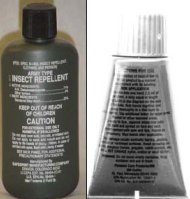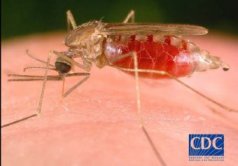

Product name: Extended Duration Topical Insect/Arthropod Repellent (EDTIAR) 
Commercial name: Ultrathon Application: DEET is designed for direct application to human skin to repel (not kill) disease transmitting insects and other biting arthropods Date of EPA approval: 30 October 1991 Type of product: insect repellent Company of manufacture: 3M Corporation Target microorganism/associated disease: Mosquitoes, sandflies, ticks, chiggers, and other biting arthropods. Major vector-borne diseases (i.e., diseases transmitted by insects) of mission-degrading potential to the U.S. military include malaria, dengue, leishmaniasis, rift valley fever virus, and various rickettsial diseases. These diseases are common in tropical and many subtropical locations around the world and no relevant licensed preventive vaccines are available. Reasons for Development: To significantly improve the efficacy of DEET (N,N-dietheyl-meta-toluamide) in preventing mosquitoes, ticks, and other pests from biting and transmitting vector-borne diseases to military personnel. Role of Department of Defense in product development: DEET (the original 75% DEET/ethanol liquid formulation earned the nickname of "bug juice") was developed by the U.S. military in 1946 as a countermeasure to malaria and other vector-borne diseases encountered during World War II. DEET products became available to the general public in 1957 (before the creation of the Environmental Protection Agency or EPA in 1970). The EPA recently re-registered DEET, and this product remains the principal repellent today. Approximately 70 different companies market 230 DEET products that are used by an estimated 50-100 million persons each year. However, DEET is an imperfect product; the application lasts for only 1-2 hours under warm, humid conditions, and DEET dissolves plastic on eyeglasses, watch crystals, protective mask eyepieces, etc. Some DEET users find the odor and oily sensation unpleasant, and rare systemic reactions following inappropriate use have been noted. Also, DEET does not repel all arthropods. The U.S. Army and United States Department of Agriculture (USDA) collaborated in developing the Extended Duration Topical Insect/Arthropod Repellent (EDTIAR). EDTIAR is a multipolymer, extended-duration formulation containing 33% DEET and polymers that slow absorption and evaporation of the repellent. This extended-duration DEET formulation provides 6-14 hours of protection under varying environmental conditions, and is considered by many to be the best repellent developed to date because it provides lasting protection with less than 50% of the active ingredient compared to past formulations. 
Current status: An EPA-approved combined camouflage face paint/DEET insect repellent product is in advanced development by the U.S. Army Medical Research and Materiel Command (in partnership with Iguana LLC of Thomasville, Georgia). In addition, U.S. military researchers are evaluating even more effective and safer candidate repellents such as picaridin to eventually replace DEET. References: Brown, M. and A.A. Herbert, 1997. Insect repellents: an overview. Journal of the American Academy of Dermatology 36:243-249. Bwire, R. Bugs in armor: a tale of malaria and soldiering. San Jose: iUniverse.com, Inc., 2001, pp. 67-81. Fradin, M.S. and J.F. Dax. 2002. Comparative efficacy of insect repellents against mosquito bites. New England Journal of Medicine 347:13-18. Gupta, R.K. and L.C. Rutledge. 1994. Role of repellents in vector control and disease prevention. American Journal of Tropical Medicine and Hygiene 50(Suppl):82-86. McCabe, E.T., W.P. Barthel, S.I. Gertler, and S. A. Hall. 1954. Insect repellents, III: N,N-diethyltoluamides. Journal of Organic Chemistry 19:493-498. Montemarano, A.D., R.K. Gupta, J.R. Burge, K. Kline. 1997. Insect repellents and the efficacy of sunscreens Lancet. 349:1670-1671. Robbins, P.J. and M.G. Cherniack. 1986. Review of the biodistribution and toxicity of the insect repellent N,N-diethyl-m-toluamide (DEET). Journal of Toxicology and Environmental Health 18:503-525. Rutledge, L.C., W.B. Reifenrath, and R.K. Gupta. 1986. Sustained release formulations of the U.S. Army insect repellent. Army Science Conference Proceedings 3:343-357. Rutledge, L.C., R.K. Gupta, Z.A. Mehr, M.D. Buescher and W.G. Reifenrath. 1996. Evaluation of controlled release mosquito repellent formulations. Journal of the American Mosquito Control Association 12:39-44. Schreck, C.E., D. Fish, and T.P. McGovern. 1995. Activity of repellents applied to skin for protection against Amblyomma americanum and Ixodes scapularis ticks (Acari: Ixodidae). Journal of the American Mosquito Control Association 11:136-140. Shapiro, JJ. The malaria problem today. Journal of the American Medical Association 132 (1946):623-7. Young, G.D. and S. Evans. 1998. Safety and efficacy of DEET and permethrin in the prevention of arthropod attack. Military Medicine. 5:324-330. |
| Extended Duration Insect Repellant | SS-LP Bednets | Premethrin Insecticide |
